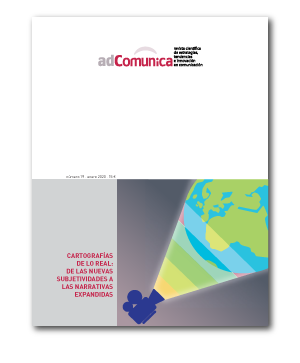Las modalidades del <i>ethos</i> en la publicidad
Contenido principal del artículo
Resumen
Este estudio se centra sobre el estatuto del ethos dentro de las estrategias contemporáneas de la publicidad y pretende comprender y analizar mediante ejemplos, cómo las marcas se presentan y gestionan discursivamente su credibilidad. La investigación se compone de tres partes, cada una responde a diferentes aspectos relacionados con este tema desde un enfoque relacionado con el dominio de la retórica y la semiótica textual.
En la primera parte, responderemos a la pregunta cuál es el ethos aristotélico y en qué medida este concepto presupone dos dimensiones principales: la primera de ellas se refiere al carácter del remitente basado en la tradición; Y la segunda de ellas se refiere a una reputación carismática relacionada con la capacidad para proyectar una subjetividad conveniente (persuasiva).
En la segunda parte, tenemos la intención de desarrollar esas ideas, respondiendo a las siguientes preguntas: ¿cómo están esas dimensiones de ethos en el registro publicitario? ¿Y cómo se puede conectar el discurso publicitario centrado en la gestión del ethos con las estrategias de imagen de marca?
En la última parte, mantendremos la posición dentro de algunas modalidades de enunciación de publicidad donde es posible dar fe de cómo se gestiona el ethos publicitario, es decir, entre aquellas en las que el emisor de publicidad se presenta explícita o implícitamente como un enunciador. ¿Cómo se incorpora esta gestión en algunas prácticas textuales?
Este estudio revisa las contribuciones epistemológicas de la retórica aristotélica, la semiótica textual y publicitaria, y complementa y profundiza las ideas ya desarrolladas en otros ensayos.
Descargas
Detalles del artículo
1. Política propuesta para Revistas que ofrecen Acceso Abierto
Los autores que publican en esta revista están de acuerdo con los siguientes términos:
- Los autores conservan los derechos de autor y garantizan a la revista el derecho de ser la primera publicación del trabajo al igual que licenciado bajo la licencia CC BY-SA, que permite a otros compartir el trabajo con un reconocimiento de la autoría del trabajo y la publicación inicial en esta revista.
- Los autores pueden establecer por separado acuerdos adicionales para la distribución no exclusiva de la versión de la obra publicada en la revista (por ejemplo, situarlo en un repositorio institucional o publicarlo en un libro), con un reconocimiento de su publicación inicial en esta revista.


